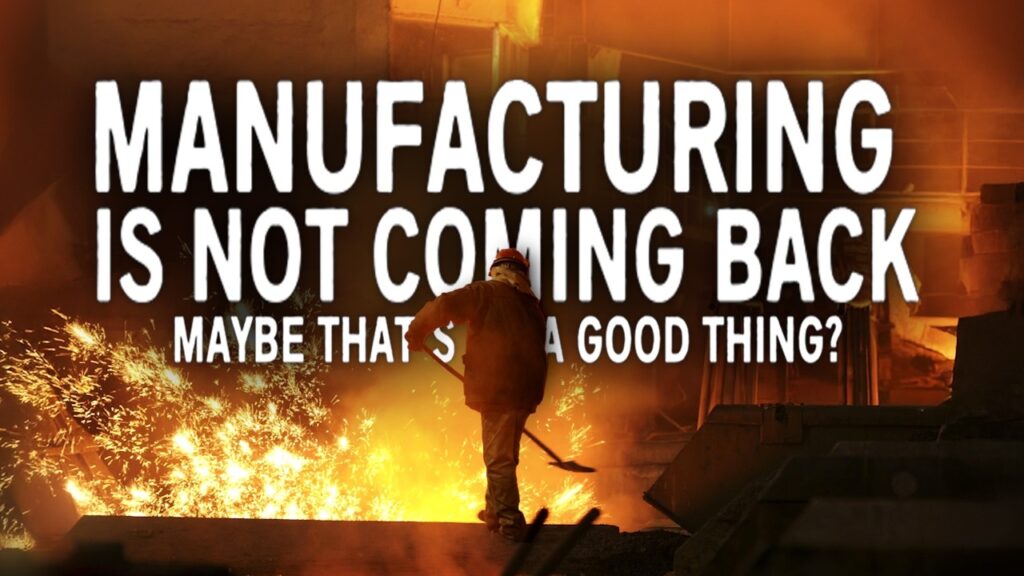Manufacturing’s Comeback or Mirage? Rethinking America’s Job Revival Strategy

We’ve been hearing a lot about bringing back manufacturing jobs. From campaign speeches to billion-dollar incentives, political and economic leaders across the spectrum are betting big on factories. But are these jobs really coming back—or are we chasing a nostalgic vision that no longer fits the modern economy?
1. The Manufacturing Shift: Where Did the Jobs Go?
Manufacturing jobs in the U.S. have declined by more than a third, even as the workforce has grown by 50%. Why? Automation, offshoring, and a shift toward service-based roles. What was once considered dangerous factory work is now seen as a stable, desirable job—especially compared to many white-collar positions that offer lower pay, fewer benefits, and less job security.
2. Political Promises and Billions in Incentives
From the CHIPS Act to sweeping tariffs and targeted bailouts, the government is aggressively trying to re-shore jobs and reinvigorate domestic manufacturing. And yes, politicians are winning elections by promising to “bring jobs back.” But the question remains—bring them back for how long, and for whom?
Despite billions being poured into factories, many of these jobs are still physically demanding and offer no long-term guarantee. The very policies designed to create jobs could eventually backfire by inflating costs, intensifying global competition, or accelerating automation to sidestep labor issues.
3. The Automation Dilemma: Factories Without People
Enter the “dark factory”—a fully automated facility running 24/7 with zero human workers. While automation boosts productivity, it threatens the very goal of job creation. Technology is outpacing workforce policy, and every robot installed potentially replaces multiple human jobs. The irony? We’re funding the comeback of manufacturing, but the real winner may be robotics companies.
4. Why Manufacturing Jobs Are Hot Again
For many men without college degrees—especially in lower-cost cities—factory work is one of the last pathways to a solid middle-class income. Rising costs of living in major metros have made blue-collar work more attractive. Strong unions in manufacturing have historically secured better pay, healthcare, and retirement benefits than many white-collar roles.
It’s not just about nostalgia—it’s about survival and stability in an increasingly unequal economy.
5. The Global Chessboard: Who’s Winning?
Outsourcing changed everything. Initially, it looked like a win-win—U.S. companies cut costs, and foreign economies grew. But now countries like China and India have used outsourced jobs as springboards to build entire industries. Even nations like Japan and South Korea are now outsourcing work to even cheaper labor markets.
Global competition isn’t just for factory workers anymore. It’s a race for skills, for intellectual capital, and for innovation.
6. The White-Collar Bubble
While factory work is getting a second look, white-collar jobs are facing a reality check. There’s been a boom in administrative and soft-skill jobs—think social media managers and ESG consultants—but many of these roles are oversaturated or loosely tied to real productivity. This “white-collar inflation” has created fewer opportunities to climb the corporate ladder and left many workers underemployed.
7. Incentives with Invisible Strings
Subsidies, grants, and tax breaks for manufacturers have largely benefited shareholders and executives—not the average worker. Despite a push to rebuild the workforce, many companies can’t find enough skilled labor due to years of underinvestment in vocational training and overemphasis on college degrees. In response, some are relying on skilled worker visas, creating tension over immigration and wage pressure.
Worse yet, most government plans fail to address the deeper problems—lack of affordable housing, weak labor protections, and poor access to healthcare—which affect all workers, regardless of industry.
8. Chasing Nostalgia, Ignoring Reality
We long for the 1950s-era dream of a factory job with good pay and a pension—but that world doesn’t exist anymore. Harvard economist Robert Lawrence points out that job creation isn’t enough. If we don’t tackle broader issues like income inequality, housing affordability, and worker representation, bringing back jobs is just window dressing.
The Bottom Line?
Bringing back manufacturing jobs sounds great in a speech—but real progress means reshaping the economic landscape, not rehashing the past. We need policies that promote dignity and security in all types of work, not just factories. The real solution? Invest in people, not just production.
All writings are for educational and entertainment purposes only and does not provide investment or financial advice of any kind.






